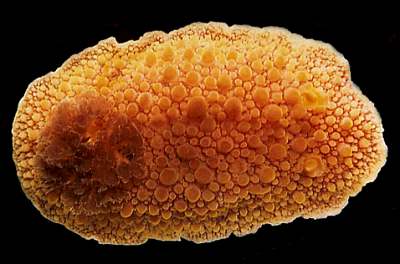Re: Peruvian dorid
October 26, 2002
From: Michael Schroedl

PHOTO: The pic shows the individual illustrated by Schroedl (1997b) - 5.5 cm; Bay of Coliumo, central Chile.
Dear Bill,
Yes, Jorge’s dorid definitely is "my old friend" A. fontaini. As you correctly point out, this is the only large cryptobranch dorid species from temperate southeastern Pacific waters that has a yellowish to orange or brown body coloration, usually a dark reticulation between the very large, sometimes flattened tubercles, triangular, grooved oral tentacles, and the upper anterior foot edge not notched. A. fontaini is one of the most common species ranging from northern Argentina throughout the Magellan region and the entire Chilean continental coast. Its northermost record was from Arica, Chile, just a few kilometers south of the Peruvian border (Schroedl, 2000). The present finding by Jorge Luque, as far as I know, is the first record of A. fontaini from Peru and extends its known range by some hundred kilometers to the north.
Possibly due to its wide range, locally high abundance and variable coloration, a bulk of synonyms exists (see Schroedl, 2000). Also the generic placement of A. fontaini is problematic. Recently, Valdés & Gosliner (2001) proposed a new generic arrangement of dorids with caryophyllidiid tubercles, synonymizing the genus Anisodoris with the senior Diaulula. In contrast to other former members of Anisodoris, A. fontaini possesses normal tubercles and triangular oral tentacles; it may be best placed into the genus Archidoris.
I think that many of the opisthobranchs known from central and northern Chile (see Schrödl, 1997a) ultimatively will be found also in Peru. Up to now, the Peruvian coast is one of the poorliest known regions of the world with regard to opisthobranchs – the only significant collectings were those by D’Orbigny (1835-1846)! I can just encourage Jorge to watch out for more opisthobranchs, he will certainly get a host of interesting findings including other range extensions and, presumably, some new species. By the way, I have prepared a catalog of all nudipleuran (Pleurobranchoidea plus Nudibranchia) species from Chile, that is based on extensive recent collectings and revision of almost all relevant type and museum material; it will appear early next year.
References:
• D'Orbigny, A. (1835-46) Voyage dans l'Amérique Méridionale exécuté pendant les années 1826-1833. Vol. 5. Mollusques. Libraire de la Société geologique de France: Paris. 758 pp. plus Atlas.
• Schroedl, M (1997a) Range extensions of Magellanic Nudibranchs (Opisthobranchia) into the Peruvian faunal province. The Veliger, 40(1): 38-42.
• Schroedl, M. (1997b) On the morphology of the Magellanic nudibranch Anisodoris fontaini (D’Orbigny, 1837), and its synonymy with A. tessellata Bergh, 1898. Veliger 40: 228-233.
• Schroedl, M. (2000) Taxonomic revision of the common South American nudibranch Anisodoris fontaini (D’Orbigny, 1837), with discussion of its systematic placement. Journal of Molluscan Studies 66: 49-61.
• Valdes, A & T.M. Gosliner. (2001) Systematics and phylogeny of the caryophyllidia-bearing dorids (Mollusca, Nudibranchia), with descriptions of a new genus and four new species from Indo-Pacific deep waters. Zoological Journal of the Linnean Society 133: 103-198.
All the best for now,
Michael
schroedl@zi.biologie.uni-muenchen.de
Schroedl, M. , 2002 (Oct 26) Re: Peruvian dorid. [Message in] Sea Slug Forum. Australian Museum, Sydney. Available from http://www.seaslugforum.net/find/8283Thanks Michael,
As you suspected, recent work has made the generic position of this species rather tenuous. I noticed yesterday that Valdes & Muniain have just published a paper on the topic (see Angel Valdes' message) suggesting it is best considered a species of Doris. I look forward to your catalogue of Chilean species in the New Year.
Best wishes,
Bill Rudman
Related messages
-
Nudibranch from Ica, Peru
From: Andre Ampuero, May 17, 2010 -
Doris fontainei from Tristan da Cunha
From: Sue Scott, November 18, 2009 -
Re: Anisodoris from Peru
From: Angel Valdes, October 26, 2002 -
Concentration of dorids in Peru
From: Jorge Luque, October 24, 2002 -
Re: Dorid from Peru
From: Bill Rudman, October 24, 2002
